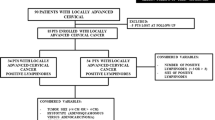Abstract
Objective
To estimate the impact of parametrial infiltration and lymph node metastasis on clinical outcome in women with early-stage cervical cancer following radical hysterectomy and pelvic lymphadenectomy.
Methods
Clinical records and pathologic slides of 532 patients with early-stage cervical cancer (330 Ib and 202 IIa) treated with radical hysterectomy and pelvic lymphadenectomy were reviewed. The study group comprised 520 patients with squamous cell carcinoma and 12 patients with adenocarcinoma of the cervix. Median follow-up time was 67 months. The association among the various histopathologic predictors of outcome was determined with analysis. The influence of the predictors on outcome was examined with log rank survival methods and the Cox regression model.
Results
FIGO stage, histologic type, tumor size, depth of invasion, parametrial infiltration, lymph node metastasis, and remote metastasis were identified as significantly biologically relevant and therefore were included as candidate predictors in multivariate analysis. In particular, parametrial infiltration and lymph node metastasis were found to be simultaneous predictors of death on multivariate analysis (P < 0.05). After controlling for these two factors, the other variables considered were not statistically significant up to a two-way interaction.
Conclusion
Presence of parametrial infiltration and/or lymph node metastasis in women with early-stage cervical cancer is an independent poor prognostic factor. In addition, the relatively poor survival of women with more than one lymph nodes identified with cancer cells.
Similar content being viewed by others
References
Greenlee RT, Hill-Harmon MB, Murray T, et al. Cancer statistics, 2001. CA Cancer J Clin, 2001, 51: 15–36.
Boffetta P, Parkin DM. Cancer in developing countries. CA Cancer J Clin, 1994, 44: 81–90.
Delgado G, Bundy B, Zaino R, et al. Prospective surgical-pathological study of disease-free interval in patients with stage IB squamous cell carcinoma of the cervix: a Gynecologic Oncology Group study. Gynecol Oncol, 1990, 38: 352–357.
Yuan C, Wang P, Lai C, et al. Recurrence and survival analysis of 1115 cervical cancer patients treated with radical hysterectomy. Gynecol Obstet Invest, 1999, 47: 127–132.
Inoue T, Okumura M. Prognostic significance of parametrial extension in patients with cervical carcinoma stages IB, IIA, and IIB. A study of 628 cases treated by radical hysterectomy and lymphadenectomy with or without postoperative irradiation. Cancer, 1984, 54: 1714–1719.
Bleker OP, Ketting BW, van Wayjen-Eecen B, et al. The significance of microscopic involvement of the parametrium and/or pelvic lymph nodes in cervical cancer stages IB and IIA. Gynecol Oncol, 1983, 16: 56–62.
Hsu WL, Shueng PW, Jen YM, et al. Long-term treatment results of invasive cervical cancer patients undergoing inadvertent hysterectomy followed by salvage radiotherapy. Int J Radiat Oncol Biol Phys, 2004, 59: 521–527.
Ho CM, Chien TY, Huang SH, et al. Multivariate analysis of the prognostic factors and outcomes in early cervical cancer patients undergoing radical hysterectomy. Gynecol Oncol, 2004, 93: 458–464.
Leath CA 3rd, Straughn JM Jr, Kirby TO, et al. Predictors of outcomes for women with cervical carcinoma. Gynecol Oncol, 2005, 99: 432–436.
Steed H, Capstick V, Schepansky A, et al. Early cervical cancer and parametrial involvement: is it significant? Gynecol Oncol, 2006, 103: 53–57.
Van de Putte G, Lie AK, Vach W, et al. Risk grouping in stage IB squamous cell cervical carcinoma. Gynecol Oncol, 2005, 99: 106–112.
Grisaru D, Covens A, Chapman B, et al. Does histology influence prognosis in patients with early-stage cervical carcinoma? Cancer, 2001, 92: 2999–3004.
Zola P, Ferrero A, Fuso L, et al. Different types of hysterectomy in the radio-surgical treatment of early cervical cancer (FIGO Ib-IIa). Eur J Gynaecol Oncol, 2002, 23: 236–242.
Lentz SE, Muderspach LI, Felix JC, et al. Identification of micrometastases in histologically negative lymph nodes of early-stage cervical cancer patients. Obstet Gynecol, 2004, 103: 1204–1210.
Morice P, Castaigne D. Advances in the surgical management of invasive cervical cancer. Curr Opin Obstet Gynecol, 2005, 17: 5–12.
Sakuragi N, Satoh C, Takeda N, et al. Incidence and distribution pattern of pelvic and paraaortic lymph node metastasis in patients with stages IB, IIA, and IIB cervical carcinoma treated with radical hysterectomy. Cancer, 1999, 85: 1547–1554.
Michel G, Morice P, Castaigne D, et al. Lymphatic spread in stage Ib and II cervical carcinoma: anatomy and surgical implications. Obstet Gynecol, 1998, 91: 360–363.
Magrina JF, Goodrich MA, Lidner TK, et al. Modified radical hysterectomy in the treatment of early squamous cervical cancer. Gynecol Oncol, 1999, 72: 183–186.
Paraskevaidis E, Kalantaridou SN, Kaponis A, et al. Surgical management of early stage cervical cancer: ten years experience from one Greek health region. Eur J Gynaecol Oncol, 2002, 23: 341–344.
Chernofsky MR, Felix JC, Muderspach LI, et al. Influence of quantity of lymph vascular space invasion on time to recurrence in women with early-stage squamous cancer of the cervix. Gynecol Oncol, 2006, 100: 288–293.
Author information
Authors and Affiliations
Corresponding author
Rights and permissions
About this article
Cite this article
Wang, H., Wu, S. & Wang, Z. Clinical outcome following radical hysterectomy and pelvic lymphadenectomy for early-stage cervical cancer. Chin. -Ger. J. Clin. Oncol. 7, 723–727 (2008). https://doi.org/10.1007/s10330-008-0122-z
Received:
Revised:
Accepted:
Published:
Issue Date:
DOI: https://doi.org/10.1007/s10330-008-0122-z




